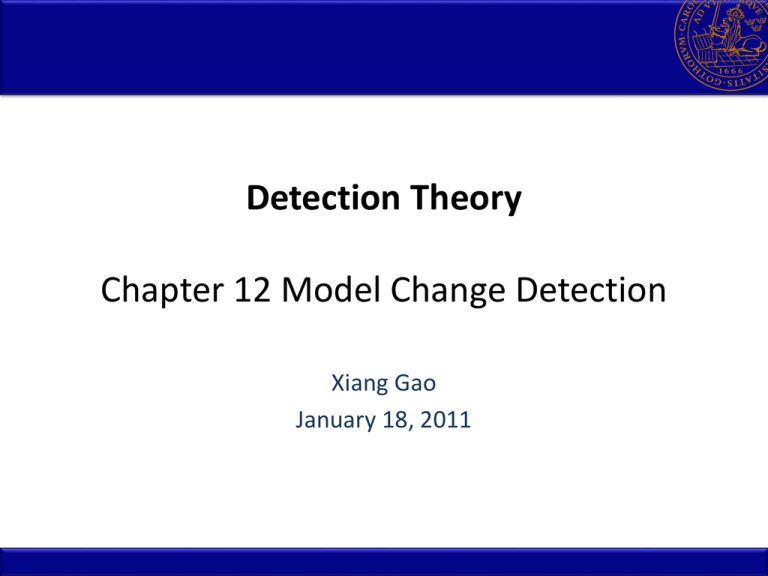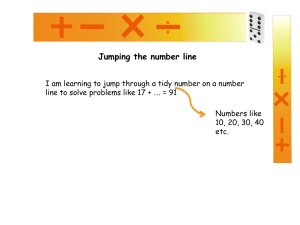Chapter 12 Model Change Detection
advertisement

Detection Theory Chapter 12 Model Change Detection Xiang Gao January 18, 2011 Examples of Model Change Detection • So far, we have studied detection of a signal in noise • Model change detection – Detection of system parameters change in time or space • In this chapter we study detection of – DC level change – Noise variance change • Examples in wireless communication – Synchronization – Detection of user presence Outline • Basic problem – Known DC level jump at known time – Known variance jump at known time – NP approach • Extension to basic problem – Unknown DC levels and known jump time – Known DC levels and unknown jump time – GLRT approach • Multiple change times • GLRT approach • Dynamic programming for parameters estimation to reduce the computation • Problems Basic Problem (No Unknown Parameters) Example 1: Known DC Level and Jump Time H 0 : x n A 0 w n n 0 , 1, , N 1 Jump time and DC levels before and after jump are known A0 w [ n ] n 0 , 1, , n 0 1 H 1 : x n A0 A w n n n 0 , n 0 1, , N 1 7 6 5 A=4 4 x[n] 3 A=1 2 1 0 -1 -2 -3 0 10 20 30 40 50 60 Sample, n 70 80 90 100 Example 1: Known DC Level and Jump Time Neyman-Pearson (NP) test • Detect the jump and control the amount of false alarm • Data PDF p ( x ; A1 , A2 ) 1 2 2 N 2 1 exp 2 2 n 0 1 x n A1 2 n0 • NP detector decides H1 L x p x; H 1 p x; H 0 ln L x A 2 p x ; A1 A0 , A 2 A0 A p x ; A1 A0 , A 2 A0 N 1 x n A 0 n n0 N n 0 A 2 2 2 N 1 x n A 2 n n0 2 Example 1: Known DC Level and Jump Time • Test statistic T x N 1 1 N n0 ' x n A 0 n n0 – Average deviation of data change over assumed jump interval – Data before jump are irrelavant • Detection performance N 0 , 2 N n 0 under Η 0 T x ~ 2 N n 0 under H 1 N A , PD Q Q 1 PFA d 2 d 2 2 Delay time in detecting a jump A 2 N n0 N n 0 A 2 2 Example 2: Known Variance Jump at Known Time H 0 : x n w n n 0 , 1, , N 1 w1 n n 0 , 1, , n 0 1 H 1 : x n w 2 n n n 0 , n 0 1, , N 1 Energy detector? 4 3 2 1 Variance = 4 0 x[n] Variance = 1 -1 -2 -3 -4 -5 0 10 20 30 40 50 60 Sample, n 70 80 90 100 Example 2: Known Variance Jump at Known Time • NP detecor decides H1 Lx p x; H 1 p x; H 0 1 L x n0 2 2 0 exp 2 1 2 2 0 n 0 1 2 x n n0 1 2 0 1 n0 2 exp 2 2 2 1 2 2 0 n 1 2 1 0 x n T x 2 2 n0 0 1 2 N 1 n n0 x n n n0 2 2 0 n n0 2 2 2 0 1 1 N 1 2 1 x n 2 2 2 n n 0 0 0 n0 x n 2 2 2 N 1 1 2 x n 2 2 2 0 n n0 N 1 2 x n n0 N 1 2 N 1 2 0 x n N 1 2 0 N n0 exp x n 2 0 2 Example 2: Known Variance Jump at Known Time • Finally, we can get test statistic T x N 1 x n 2 ' n n0 – It is an energy detector – Same as detecting a Gaussian random signal in WGN (Chapter 5) Extensions to Basic Problem (Unknown Parameters Present) Example 3: Unknown DC Levels, Known Jump Time • Assume n0 is known but DC levels before the jump A1 and after the jump A2 are unknown H 0 : A1 A2 H 1 : A1 A2 • GLRT detector decides H1 if Aˆ 1 N Aˆ 1 Aˆ 2 1 n0 N 1 x n x Average over all the data samples n0 n 0 1 x n Average over data samples before jump n0 1 N n0 N 1 x n n n0 p x ; A 1 Aˆ 1 , A 2 Aˆ 2 LG x ˆ ˆ p x ; A 1 A , A2 A Average over data samples after jump Example 3: Unknown DC Levels, Known Jump Time • After some simplification, we decide H1 if 2 ln L G x Aˆ 1 Aˆ 2 2 1 2 1 n N n 0 0 ' • PDF of test statistic 1 1 2 under H 0 N 0 , n0 N n 0 Aˆ 1 Aˆ 2 ~ 1 N A A , 2 1 under H 1 2 n 1 N n 0 0 12 under H 0 2 ln L G x ~ 2 1 under H 1 A1 1 2 n0 A2 2 N n 0 1 Example 4: Known DC Levels, Unknown Jump Time • Now the case is: A0 and ΔA are known, but n0 is unknown • This is classical synchronization problem • GLRT detector decides H1 if Same as Example 1 p x ; nˆ 0 , H 1 L G x max p x; H 0 n0 ln L x ; n 0 ln L G x A A 2 2 N 1 max L x ; n 0 n0 x n A0 n n0 ( N n0 ) A 2 2 2 A 2 N 1 A x n A 0 2 n n0 N 1 max N 1 n0 A x n A 0 2 n n0 A T x max x n A0 n0 2 n n0 Test statistic is maximized over all possible values of n0 Final Case: Unknown DC Levels, Unknown Jump Time • DC levels as well as jump time are unknown • GLRT decides H1 if max n0 Aˆ 1 Aˆ 2 2 1 1 n N n 0 0 2 MLE of DC levels: Aˆ 1 Aˆ 2 1 n0 n 0 1 x n n0 1 N n0 N 1 x n n n0 ' Multiple Change Times Multiple Change Times Parameter’s value changes more than once in data record For example: DC levels change multiple times in WGN 9 A=6 8 7 A=4 6 x[n] 5 A=2 4 A=1 3 2 1 0 -1 0 10 20 30 40 50 60 Sample, n 70 80 90 100 Multiple Change Times • No unknown paramters – Same as Example 1 • Unknown parameters – DC levels unknown, change times known Same as Example 3 – Change times unknown Computational explosion with the number of change times Example 5: Unknown DC Levels, Unknown Jump Times • We have signal embedded in WGN n 0 , 1, , n 0 1 A0 A1 s n A2 A3 n n 0 , n 0 1, , n1 1 n n1 , n1 1, , n 2 1 n n 2 , n 2 1, , N 1 • GLRT can be used if we can determine the MLE of change times • Focus on estimation of DC levels and change times • Joint MLE of A A A A A and n n n n 1 Aˆ x n n n To minimize T 0 1 2 T 3 0 1 n i 1 2 i i J A, n n 0 1 x n n0 A0 2 n1 1 x n A1 n n0 n 2 1 2 x n A2 n n1 N 1 2 x n n n2 i 1 n n i 1 A3 2 Example 5: Unknown DC Levels, Unknwon Jump Times Dynamic programming • Not all combinations of n0, n1, n2 need to be evaluated • Reduce computational complexity i n i 1 , n i 1 n i 1 x n Aˆ i 2 n n i 1 n J Aˆ , n 3 i i 1 , n i 1 Recursion for the minimum i0 I k L k min n n 0 , n1 ,..., n k 1 n 1 0 , n k L 1 i 0 i i 1 , n i 1 min I k 1 n k 1 1 k n k 1 , L n k 1 • Effectively eliminate many possible ”paths” Problems • • • • • 12.1 12.2 12.4 12.6 12.11







